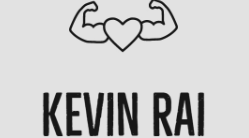4 Unique Front Squat Grip: Full Guide

Your front squat grip directly influences how well you can stabilize the barbell on your shoulder during the lift.
If your grip is not secure throughout the movement, it can cause the bar to roll forward~ compromising your balance and form of your squat.
Just a little forward shift in the bar can significantly increase the force upon your body, this is why most people find this lift harder than back squat.
This article will dive into various front squat grips and explore the techniques for achieving a solid grip, and explain the benefits of proper grip technique.
Types Of Front Squat Grip
There are three main types of grip:
- Clean Grip
- Strap Grip
- Cross Arm Grips
- Zombie (Bonus)
Applying different grips offers you the flexibility to choose an exercise that works well with your body’s mechanics, mobility levels, and training goals.
Swapping grips slightly changes the force being put upon your body, which will challenge you in a different way.
Clean Grip
The clean grip is probably the most common type of grip used among lifters for front squats.
It is performed by holding the barbell with your fingertips across your front deltoid and collarbone~ this hand placement mimics the grip used in Olympic weightlifting.
- Position the barbell on the squat rack at upper chest height and load it up with the appropriate weight.
- Place your hands slightly wider than shoulder-width apart on the barbell.
- Get underneath the bar so it’s touching your collarbone.
- Twist your hand underneath the bar and grab a hold of it (your palms should be facing the ceiling.
- Drive through your leg to lift the bar off the rack and rest it on your front deltoid.
- Take a few steps away from the rack and position your feet how you would normally squat.
- Unlike back squats, you have to keep your torso upright while you squat to help prevent the bar from rolling forward.
Tips
- While gripping the bar, lift your upper arm until it’s parallel to the floor, as this will help you balance the bar on the front shoulders.
- You might have difficulty holding the bar with all your fingers in the beginning. In this case, you can start by just using your index and middle fingers and slowly incorporate the other fingers as your mobility improves.
Pros
Cons
Cross Arm Grip
If you want to eliminate the shoulder & wrist mobility out of the lift then a cross-arm grip is perfect for you.
The bar is positioned at the exact same spot, but your hands are crossed over in front of you~ allowing you to lift your elbow up more easily.
- Put your arm straight forward in front of at shoulder-width apart.
- Walk underneath the barbell, until it’s touching your collarbone.
- Cross your arm and lightly press down on the barbell.
- Unrack the bar by straightening your body
- Take a couple of steps away from the rack and you are ready to squat.
Tips
- Even though the grip is easier on the shoulder and wrist, it’s much harder to stabilize the bar, making it likely to round your upper back. So stick with lighter weights to perfect the form before lifting heavier weights.
- Don’t fully grab the bar, just push down on it with an open palm
Pros
Product Cons
Strap Grip
A strap grip is a similar movement to a clean grip.
The difference is you wrap the strap around the bar and hold the end of it. This gives you a higher leverage so your wrists don’t have to bend as far.
- Wrap your straps around the bar tightly at a shoulder-width distance.
- Same as with a clean grip, get underneath the bar.
- Grab the end bit of the strap under and over the bar, so your upper arm is parallel to the ground.
- Secure the barbell on top of your shoulders and un-rack it.
Tips
- Don’t let your elbows drop during the exercise. The lower they drop, the more the bar will roll forward which will increase the pressure on your upper back.
- Refrain from wrapping the straps over your hands. The reason is in case you need to drop the bar for reasons such as losing your positioning~ you can’t drop it safely if you are attached to the bar.
Product Pros
Product Cons
Zombie (Bonus)
This is not really a grip variation, but I added it to the list as a bonus since it’s an interesting way to perform the front squats.
It’s not a grip variation because you don’t hold the bar at all. You just straighten your arms like a ‘zombie’ and balance the bar on your shoulders.
Not being able to hold the bar immensely challenges your back and core muscles. You need to work extra hard to keep your torso upright to prevent the bar from rolling forward.
This makes it the toughest to execute out of the other types of squats.
- Bring your arms straight in front of you and have them parallel to the ground.
- Slowly walk underneath the barbell, and have it resting on your upper shoulders.
- Without changing your hand position, unrack the bar and take a few steps back.
- The goal is to squat while maintaining straight hands.
Tips
- Roll your shoulder blade back before you squat down. This will help you to engage your upper back muscles during the lift.
- Shift your weight towards your heels and it will help you maintain an upright position.
Pros
Cons
Techniques For Achieving a Solid Front Squat Grip
Achieving a solid front squat grip is essential for maintaining proper form, stability, and comfort during the exercise.
This will apply more to a clean grip than the other front squat grip, but it’s still important to work on these techniques to improve your overall lift.
Mobility & Flexibility
Improving your wrists & shoulder mobility and flexibility is essential for being able to perform front squats smoothly, especially for a clean grip.
Not only that but if you lack in this department it can lead to pain or injuries for only with fronts squats but with other various exercises as well.
Wrists stretch
- Extend one arm in front of you with the fingers pointing down.
- Use the opposite hand to apply gentle pressure to your fingers, pulling them back towards your body.
- Hold the position for 20-30 seconds then repeat the same process on the other hand.
- Afterward, rather than having the fingers pointing down, have them facing up instead.
- Then with the opposite hand slowly pull your fingers towards your body and hold for 20-30 seconds.
Shoulder stretch
- Stand with your back against a flat wall.
- Your heels should be a few inches away from the wall and have elbows bent at 90 degrees against the wall.
- Slowly slide your arms up while maintaining contact with your elbows, forearms, and hands to the wall.
- Go high as you can and pause for a few seconds.
- Lower your arms back to the starting position. Aim for 8-12 repetition
Hand Placement
Once you improve your flexibility, another essential factor is your hand placement.
Depending on where you hold the bar, it can drastically change your ability on how well you can stabilize it.
Now no one hand placement fits all individuals. It will depend on your body structure and the type of front squat grip you choose.
You need to play around and see what feels comfortable. But here is a rough guide to what you should be looking for:
- The correct hand placement will create a stable shelf for the barbell to rest on your shoulders and collarbone.
- Proper hand placement will contribute to an upright torso position.
- While alongside working on your flexibility, a correct hand position should help minimize the load being put on your wrists.
- You should not feel the bar rolling forward during the squat.
- It will allow the load to be distributed evenly across your shoulders and collarbone.
Bar Positioning
What comes next is how you position the bar on your body.
No matter which front squat grip you decide to go with, the bar will be resting in the same area of your body.
When you have your hand placement ready and unrack the bar, it should be positioned on top of your front shoulders and across your collarbone.
It should be touching your neck where you feel a slight choking sensation, but not close enough that you can’t breathe at all.
Elbow Placement
The position of your elbows is probably the most important factor that supports keeping the bar secured in the correct position.
Your elbows should stay parallel to the floor while you squat which will stop the bar from shifting forward.
Benefits of Proper Front Squat Grip
There are several advantages of perfecting your grip in order to advance in front squats.
Enhanced Stability
Perfecting your grip will allow you to position the barbell in a way that evenly distributes the weight across your shoulders and collarbone.
Therefore it prevents the barbell from tilting forward or backward~ keeping you in a stable position
Correct Muscle Engaged
When the bar stays in the optimal position throughout the lift and has minimal movement~ it makes it easier to stay in an upright torso position.
Staying in the upright position will target more of your quads and glutes which is the primary target of this exercise.
Prevents Injury
As the bar is placed in front of you, it puts added pressure on your back compared to the regular back squat. This makes it crucial to have an upright torso to maintain a proper spinal alignment.
The more the bar shifts forward, the more likely you are to round your back. This rounding will increase the pressure on intervertebral discs which act as cushions between your spine.
Excessive force on these disks can lead to herniation or bulging causing pain or even potential long-term issues.
Push Heavier Weights
When the bar is stable on your shoulders, you waste less energy on maintaining the bar’s position, and you can direct all your focus on pushing the weight up.
Having an upright torso and minimizing excessive forward lean will support maintaining a proper spinal alignment.
This allows you to effectively transfer force from your lower body to the barbell and push more weights.
Common Mistakes to Avoid
Don’t Lift Weight With Round Back
First and foremost the most important of all is don’t grind out weights with a rounded back.
I know sometimes we can get carried away in the strength world and we just want to lift heavier weights to build strength. But whenever you feel as though your back starts collapsing, it’s better to stop right there than increase your chance of facing an injury.
Don’t Let Your Elbow Drop
As you start fatiguing during the exercise, your elbows will naturally want to drop down.
You need to pay extra attention to this happening because remember letting your elbows drop during the squat can cause the bar to roll forward and disrupt your balance.
Therefore pause for a few seconds if you need to, take a big breath, and push those elbows back up.
Knee Collapse
During your squat avoid the knees collapsing inwards towards each other as it puts excessive stress on the knee joints.
Instead, actively push your knees outwards by imagining spreading the floor apart with your feet.
Conclusion
Mastering the front squat grip is a critical aspect of ensuring your lifts are safe and effective.
No matter the grip you choose- whether it’s the clean grip, cross-arm grip, or strap grip~ it directly impacts your stability, form, and muscle engagement.
Remember the grip technique can slightly vary based on your body’s unique mechanics and structure. So take time to play around to see what works and doesn’t.
Good luck on your fitness journey!!


